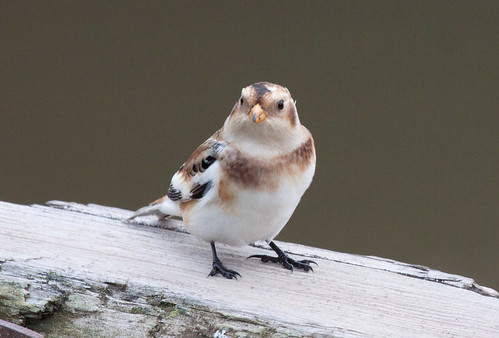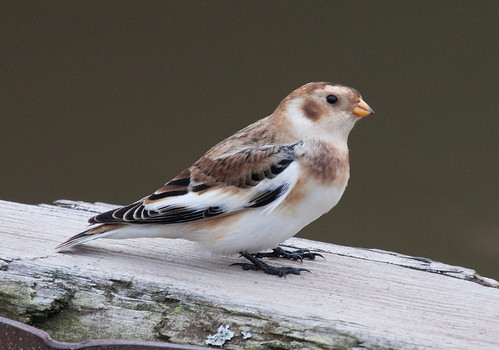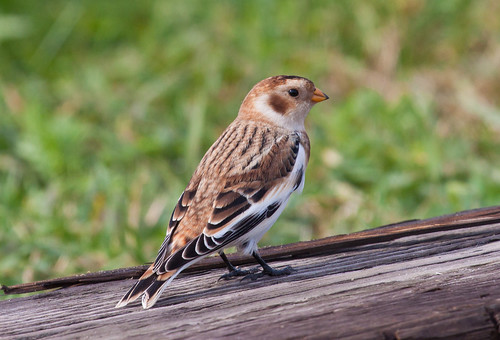(This is the transcript of a radio program I produced November 13, 2007. It has interesting information about Snow Buntings. Tragically, I don't have any photos of Snow Buntings in spring, or in flight.)
One of the loveliest visitors from the far north is the Snow Bunting. The large white patches on its wings and body give it a sparkly, twinkling effect when it flies, and gave it the nickname “snowflake.” If one Snow Bunting in flight is pretty, a whole flock is breathtaking. Snow Buntings at the back of a flock have an interesting habit of advancing quickly to the head of the flock as the birds move along, giving the whole group’s movements a rolling effect, enhanced in beauty by the sparkling individual snowflake birds.
Snow Buntings weigh in at about two ounces, but are way, way hardier than we mere humans are. They’re the first migrants to return north each spring. Males return to the Low Arctic in mid-March, and to the High Arctic in early April, when temperatures can still plunge to 30 below zero. This species doesn’t nest in the open, but rather in rock cavities. Although this protects the female and her young from predators and shelters them from high winds, it actually affords a very cold microclimate, with no sun to warm them and exceedingly cold temperatures from the rocks. So females stay on the nest virtually all the time, meaning their mates must find enough food for both of them. They eat mostly weed and grass seeds in winter and spring, but as insects become available in later spring through summer and into autumn, they voraciously gobble them up for animal protein, which their growing babies especially need in abundance.
With limited and very specific nesting spots to compete over, successful males must arrive early each year, and so this species often suffers devastating losses during spring storms. Females don’t return for four or even six weeks after males. They’re equally competitive with other females for territories that hold a good male and nest spot, but can't afford to migrate as early, because females lose too much in the trade-offs involved in early migration. Unlike males, female bodies must be in prime condition to produce five or six eggs and share their body heat with them for 10 to 15 days, and then keep the babies warm for several days more.
Snow Buntings can survive air temperatures down to 50 below zero, which is extremely hardy, but not quite as extreme as redpolls, which can survive down to 60 below. I don’t even want to think about the laboratory experiments that established this.
Snow Buntings molt their feathers in mid-summer. The molt takes place in a short time, and so many flight feathers are replaced at once, rather than one by one, that many birds undergo a flightless period, fortunately during the time of year when food is most abundant. Many of the new feathers have brownish or rusty tips. In spring, they spend a great deal of time taking snow baths, scraping their feathers against icy crystals, which breaks off those dull feather tips, revealing the males’ spectacular black and white plumage. Molting is dangerous for a species that spends much of its time in a harsh environment. This way they only need to do it once a year, giving them their thickest, warmest feathers in winter and not revealing their beautiful breeding plumage until it’s getting warm enough to shed the feather tips.
Snow Buntings are still captured and killed for food in some places in Quebec, but overall these birds, surprisingly tame around their nesting grounds, are enjoyed and not harassed by people. Their habitat and future are as secure as the northern climate will allow.


